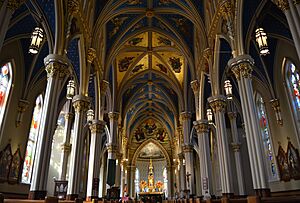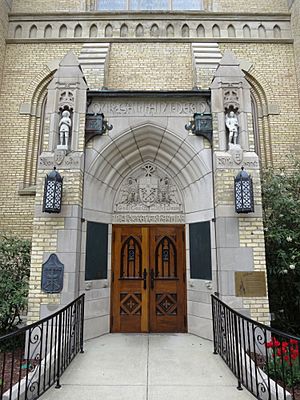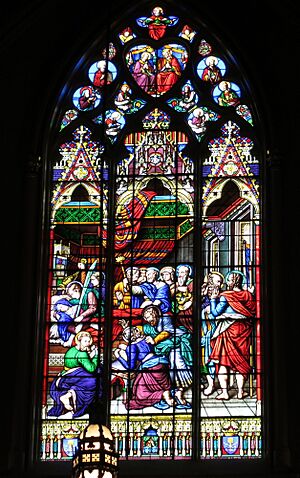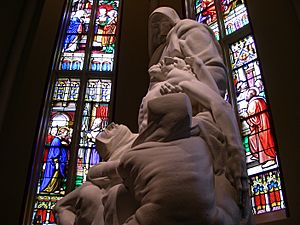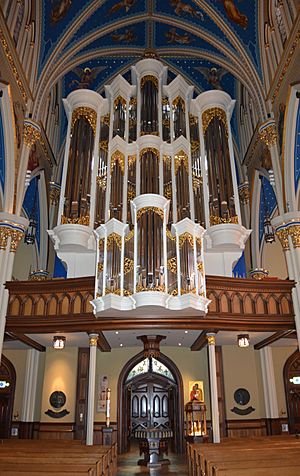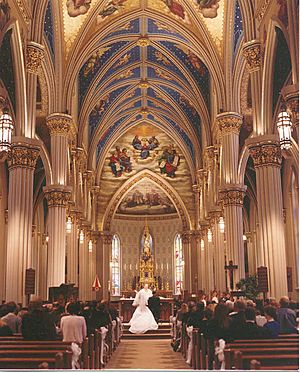Basilica of the Sacred Heart (Notre Dame) facts for kids
The Basilica of the Sacred Heart is a beautiful Catholic church located on the campus of the University of Notre Dame in Notre Dame, Indiana. It's also the main church for the Congregation of Holy Cross in the United States. This amazing church is built in a style called Gothic Revival, which looks like old European cathedrals. It has 44 large stained glass windows and incredible paintings that took 17 years to finish, created by a Vatican artist named Luigi Gregori.
The church's bell tower stands tall at 230 feet, making it the highest university chapel in America! It's a special building listed on the National Register of Historic Places. Many people visit the Basilica every year, with over 100,000 tourists coming to see it.
Quick facts for kids Basilica of the Sacred Heart |
|
|---|---|
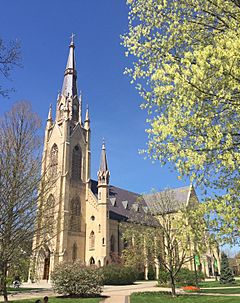
Basilica looking northwest from the Main Quad
|
|
| Location | University of Notre Dame Notre Dame, Indiana |
| Country | United States |
| Denomination | Catholic Church |
| History | |
| Status | University church Mother church of the Congregation of Holy Cross in the United States |
| Consecrated | 15 August 1888 |
| Architecture | |
| Functional status | Active |
| Architect(s) | Edward Sorin, Alexis Granger |
| Architectural type | Basilica |
| Style | Gothic Revival |
| Groundbreaking | 1870 |
| Specifications | |
| Capacity | 1,000 |
| Length | 275 feet (84 m) |
| Width | 114 feet (35 m) |
| Height | 230 feet (70 m) |
| Materials | Brick, limestone |
| Bells | 23 (1867) |
| Tenor bell weight | 7 long tons 0 cwt (15,700 lb or 7.1 t) |
| Administration | |
| Diocese | Fort Wayne–South Bend |
Contents
History
In 1686, a priest named Fr. Claude-Jean Allouez started a mission called Ste-Marie-des-Lacs. It was for the local Potawatomi tribe and French settlers. Later, in 1832, Stephen Badin restarted the mission and built a small Log Chapel.
The First Church
When the University of Notre Dame was founded by Rev. Edward Sorin, people first worshipped in Stephen Badin's small log cabin. This was replaced by a slightly larger log cabin in 1843.
But this log chapel soon became too small. So, in 1847, Father Sorin decided to build a proper church. Work began in 1848, and the church was finished and dedicated in 1849. It was 90 feet long and had two towers. It was built in a style called Carpenter Gothic.
In 1851, a strong wind blew down the church's tower and bell. University leaders bought a bigger bell, weighing over 3,200 pounds, and put it in one of the church towers. They also added double spires. The church had beautiful stained glass windows from France.
The Present Church
The university kept growing, and the first church became too small again. So, in 1869, leaders decided to build a new, much larger church. This new church would be dedicated to Our Lady of the Sacred Heart.
The first plans were very grand, but Father Sorin thought they were too expensive. So, new plans were drawn up in 1870. The new church was designed in the Gothic Revival architecture style. This style was popular in France and Father Sorin liked it.
Building the new church started in 1870. The first Mass was held in the unfinished building on August 15, 1875. The Lady Chapel was added in 1887. Finally, the new church was officially blessed on August 15, 1888. The tall steeple was finished in 1892.
The stained glass windows for the new church were ordered from France. They were made by Carmelite nuns and later by other companies. Father Sorin carefully chose the scenes for the windows. He wanted them to teach important lessons.
In 1899, the church was the site of the very first wireless transmission in the United States. This was a big step for radio technology!
The church has also hosted important events. In 1931, it was the location for the funeral of famous football coach Knute Rockne. His funeral was even broadcast on the radio. The church was also visited by Eugenio Pacelli, who later became Pope Pius XII, in 1936.
Recent History
In the late 1960s and early 1970s, the church was updated. Some changes were made to the altars and other parts to fit new church practices.
About 20 years later, in the 1990s, the church was renovated again. Some of the earlier changes were reversed, bringing back more of the original decorations. The old stained glass windows were also carefully cleaned and repaired.
On January 17, 1992, Pope John Paul II gave the Church of the Sacred Heart the special title of "Minor basilica". This was something Father Sorin had wanted for a long time. This special title makes it a popular place for visitors.
The Basilica has been the site of funerals for many important people from the Notre Dame community, including former university president Theodore Hesburgh and TV host Regis Philbin. In 2021, Patriarch Bartholomew I of Constantinople, a very important leader in the Orthodox Christian church, visited the Basilica.
Exterior
The outside of the church is made of brick. It has a tall bell tower with a pointed spire. The bell tower is 218 feet tall. On top of it is a 12-foot golden cross. This makes the total height 230 feet, the tallest building on campus.
World War I Memorial Door
After World War I, people at Notre Dame wanted to create a memorial for those who served. They designed a special door on the east side of the Basilica. This door is made of oak with iron hinges. It has two stained glass windows with a Tudor Rose and a Poppy.
Above the door, it says "In Glory Everlasting." There's also a carved panel with two eagles holding a shield. The words "Our Gallant Dead" are carved into the stone above the door. Statues of Jean of Arc and St. Michael were added to the door in 1944. The World War I Memorial Door was officially dedicated on Memorial Day in 1924.
Interior
Altars
The Basilica has three altars. The main one is a beautiful Gothic Revival altar made of bronze. It was built in Paris and won an award at an exhibition in Philadelphia. Father Sorin bought it for the church. The small tower on this altar holds the Blessed Sacrament.
After the Second Vatican Council, the main altar was moved. A new wooden altar was placed closer to the people. The third altar is in the Lady Chapel. It is a Baroque style altar and is believed to come from the studio of Gian Lorenzo Bernini, a famous Italian artist.
Next to the main altar, you can see two special objects: an Umbraculum and a Tintinnabulum. These are colorful symbols that show the church has the special title of a minor basilica. The baptismal font, where baptisms happen, is located at the entrance and dates back to 1871.
Frescoes
The walls and ceilings of the church are covered with amazing paintings called frescoes. These were painted by Luigi Gregori, an artist from the Vatican. The ceilings look like a starry sky with angels. The walls and transept (the arms of the cross-shaped church) are decorated with figures of saints. There are 96 painted angels on the vaulted ceiling! Gregori also painted the Stations of the Cross that are on the walls.
The frescoes show many saints. For example, on the left side of the main area, you can see Anthony of Padua and Francis of Assisi. On the right side, there are John the Baptist and Mary Magdalene. In the choir area, you'll find paintings of the Sacred Heart of Jesus and the Immaculate Heart of Mary.
At the center of the church, the ceiling is gold. It has figures of the four evangelists (Matthew, Mark, Luke, John) and Old Testament prophets like Isaiah and Moses. The paintings in the transept show scenes from the life of Mary, like her birth and the Annunciation. A large fresco at the entrance of the Lady Chapel shows Mary being crowned as Queen of Heaven.
In the Lady Chapel, Gregori painted a bright scene of the True Cross being honored. It shows the cross surrounded by angels and saints. St. Patrick is even included, holding a clover, to honor Notre Dame's Irish heritage.
Windows
The Basilica has 116 stained glass windows, with over 1,200 individual panels! They were made in France by the Carmel du Mans Glassworks. These windows were installed over 15 years, starting in 1873. Father Sorin carefully chose what each window would show.
The windows tell different stories in different parts of the church. For example, the windows near the entrance show God's mercy. The windows in the main area show saints. The windows in the transept are about the Church. The most important saints are shown in the sanctuary windows.
Each of the 16 windows in the main area and transepts shows four saints. For example, one window shows four saints who were kings, and another shows four who were nuns. There are also windows showing important Church leaders like Augustine of Hippo and Saint Jerome.
One large window in the west transept shows the Sacred Heart of Jesus, which is what the Basilica is named after. Another window shows Father Sorin presenting the church building to God. The windows in the Lady Chapel tell stories from Jesus's life.
Side Chapels
The Basilica has seven smaller chapels on its sides.
- The Chapel of the Holy Cross has the tomb of John Francis O’Hara, who was a university president and later a cardinal. It also has a statue called Return of the Prodigal Son.
- The Chapel of Our Lady of Victory contains a statue of Blessed Basil Moreau, who founded the Congregation of Holy Cross. This chapel was added after Father Sorin survived being lost at sea and believed Mary helped him.
- The Chapel of Holy Angels has a modern painting of Our Lady of Guadalupe. Its stained glass windows show the three main archangels from the Bible: Michael, Raphael, and Gabriel.
- The Lady Chapel is the largest chapel behind the main altar. It has a beautiful statue of Mary and a Baroque altar believed to be from Bernini's studio. The windows here tell stories from Jesus's life and about the devotion to the Sacred Heart.
- The Reliquary Chapel holds special relics, which are sacred objects. These include pieces believed to be from the True Cross and relics of St. Severa. The windows show stories about finding and moving relics.
- The Brother Andre Chapel honors Andre Bessette, the first saint from the Congregation of Holy Cross. He was known for helping those in need. The windows show scenes from Mary's life.
- The Holy Family Chapel honors St. Joseph and contains a famous statue called the Pietà by Ivan Meštrović. This statue shows Mary holding Jesus after his crucifixion. The windows in this chapel show stories about the Holy Family.
Organ
The Basilica has a very impressive organ. The first organ in the earlier church was small. In 1875, a larger organ with 2,000 pipes was installed in the new church. Over the years, the organ was updated and replaced several times.
In 2016, a brand new organ, called the Murdy Family Organ, was installed. It was built by Paul Fritts & Company. This huge organ has 4 keyboards, 70 stops, and 5,164 pipes! It stands 40 feet tall and weighs more than 20 tons. Before it could be installed, the choir loft had to be strengthened to hold its weight. This amazing instrument was finished just in time for Christmas 2016.
Basilica Museums
The Basilica has two museums. The main museum is behind the sacristy (a room where priests prepare for services). It displays items from the history of the university and the Congregation of Holy Cross. You can see things that belonged to Father Edward Sorin, who founded the university. There are also old church items, personal belongings of the artist Luigi Gregori, and even a special hat called a papal tiara that was given to Father Sorin by Pope Pius IX. This tiara is one of only two like it outside the Vatican!
The basement has the Bishop's Museum. It holds items that belonged to different American bishops from the 1800s. You can see fancy robes, hats, shoes, and other church items.
Liturgies
The Basilica is the main place for religious services at the university. Mass is held twice a day when classes are in session. On weekends, there are three Sunday Masses for students, staff, and the community.
Many Notre Dame alumni choose to get married in the Basilica. It's also where new priests are ordained and where funerals are held for members of the religious community and alumni.
Every Sunday evening, the Basilica holds a special prayer service called Solemn Vespers. During Advent, there's a beautiful service called Lessons and Carols. During Lent, Stations of the Cross are celebrated every Friday. The special Easter celebrations, called the Paschal Triduum, are very popular and well-attended.
Two important people are buried in the Basilica: Cardinal John Francis O'Hara in the Chapel of the Holy Cross, and Orestes Brownson in the crypt (basement).
Broadcasts
Since 2002, Sunday Masses from the Basilica have been broadcast across the country. This allows many people to participate in the services. The 10:00 A.M. Mass is shown on CatholicTV, and the 11:45 A.M. Mass can be watched online.
Carillon
The Basilica has a set of 23 bells, called a carillon, that were installed in 1856. This is the oldest carillon in North America! The bells were made in France, and each one has a name related to Mary. The largest bell, added in 1888, is named for St. Anthony of Padua. It's huge, weighing 15,400 pounds!
Images for kids
See also
 In Spanish: Basílica del Sagrado Corazón (Notre Dame) para niños
In Spanish: Basílica del Sagrado Corazón (Notre Dame) para niños


